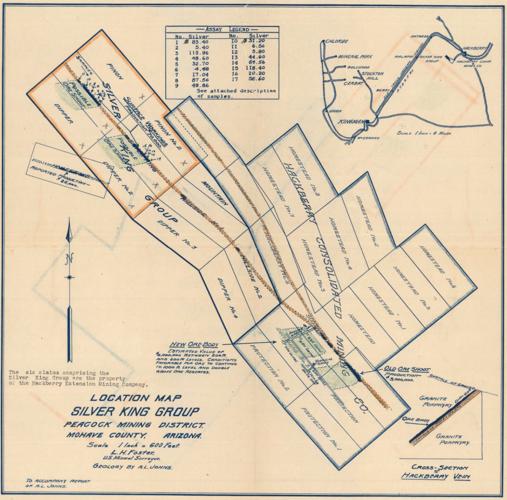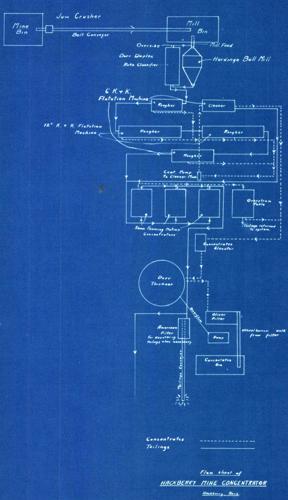Four men were wandering the northeast slope of the Peacock Mountains in search of water on Oct. 12, 1874, after their horses were taken by Indians when they discovered a silver ledge that became the Hackberry Mine.
Samuel Crozier, William Ridenour, J.D. Putman and J.A. Kile filed the first mining claims at Hackberry, which they named after a tree they saw by a nearby water source. The Peacock Mountains are in Mohave County in northwestern Arizona.
Early operations, as part of the Silver King group of mines, involved chloriders using windlasses to excavate high-grade silver ore at 50 feet or less in depth. They packed their ore on burros to be transported for processing at a nearby amalgamation mill.
In 1876, a San Francisco group of investors purchased the mine, located 27 miles northeast of Kingman in the Peacock Mining district. Soon after, the mine yielded 222 bars of silver valued at $222,705.
After being shut down over mismanagement, it was taken over by the Hackberry Mining and Milling Co. in 1881. It operated until 1884.
Around this time, the town of Hackberry, a mile and a half east of the mine, gained prominence with the opening of a general store by James Dundan. Also, Dr. Warren E. Day opened up medical offices to care for men who worked for the Arizona Pacific Railroad. The killing of a town local by an outlaw prompted the town’s first hanging.
The population reached 400 and the town was soon relocated several miles closer to the railroad. It served as a major shipping point for cattle in the late 1890s and as a stop for the railroad, serving as the only source for fuel oil between Seligman and Needles.
Exploration and development prompted the Hackberry Mine to reopen in 1914 due to discovery of a large tonnage of low grade or milling ore left behind at the site. Technological advances in oil flotation enabled miners to extract these remaining ores at a profit. The mine was credited with $750,000 to $3 million in silver and gold production from 1875 to 1917. However, litigation matters hindered full development of the mine’s reserves.
A report provided by mining engineer A.L. Johns in 1918 described a 22-foot wide and 19-foot high vein at the 600- and 700-foot levels of the mine, averaging 32 ounces of silver per ton. Johns reasoned the mine had the potential to produce 450,000 mineable tons, along with secondary deposits of gold, copper, lead, zinc and cadmium.
The mine was then operated by James Murray, a renowned mine owner in Butte, Montana, along with William Neagle and Gus S. Holmes. A 200-ton flotation mill was built near the collar of the shaft.
Flooding in 1921 caused the mine to be shut down again. Intermittent lessee operations at the mine site continued over the ensuing decades. A small shipment of 1,117 tons of copper by mine lessee Henry Galbraith was shipped to a local smelter in 1943.
Work commenced in 1980 with three 4,000-ton capacity leach pads constructed to cyanide leach the Hackberry Mine dump. Water was acquired from a nearby old mine shaft. An onsite bullion furnace was built to smelt and refine the silver. Thomas A. Roberts operated the mine, incorporated as Northern Arizona Minerals and owned by Nicholas Hughes of Las Vegas. His operation involved dewatering and underground ore sampling. The mine was described as including 12 patented and 10 unpatented lode mining claims replete with five shafts. The main shaft is 950 feet deep.
The property is currently owned by the Hughes Family Trust.






